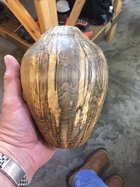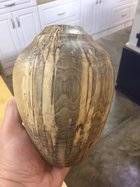A few times I've had what I call "banding" show up on hollow forms right at the transition of the curve from bottom to top. It doesn't show up in my mineral spirits wipe and isn't due to scratches to tool marks. It jumps out when I put on oil. It's rare and I pay close attention to sanding up to that part of the curve from top and bottom as well as the transition. I try to make sure the surface is consistent re sanding direction and pressure up to and around the bend. I suspect it's due to the change from mostly pure side grain on that "band" to side and end grain as it curves away. On dark spalted wood it can be very noticeable as you can see. My remedy is to put it back on the lathe and, as messy as it is, go back to 80 or 120 grit and work the area up and down until I get a better blend. I was able to greatly reduce the banding on this piece but wondering if anyone with more experience has a trick for catching it before I apply oil. Water instead of MS maybe?
I know it's not terrible to the average observer but it's one of those things that jumps out at me and becomes all I see when I look at it.
I know it's not terrible to the average observer but it's one of those things that jumps out at me and becomes all I see when I look at it.


